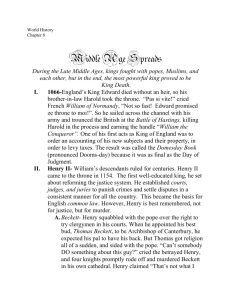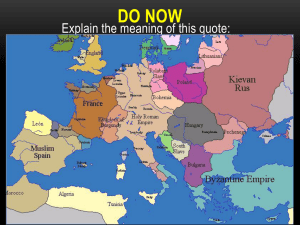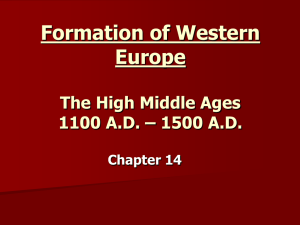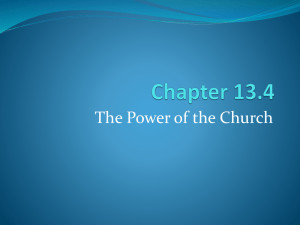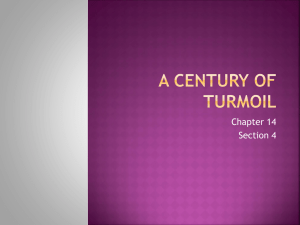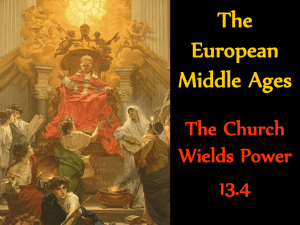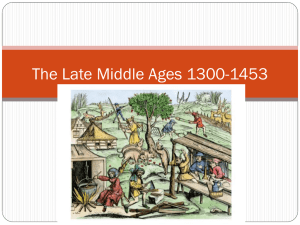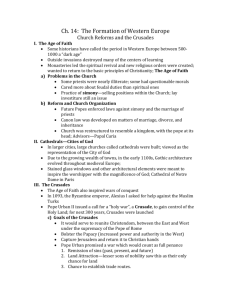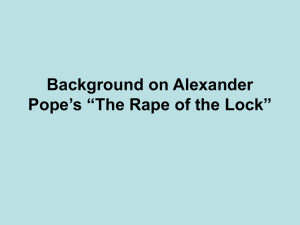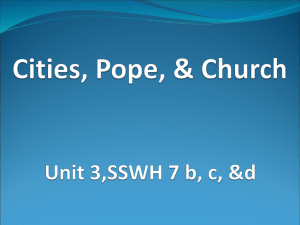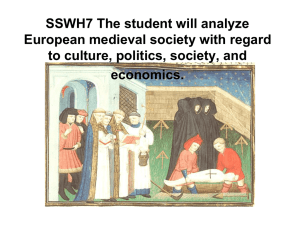The Late Middle Ages: Social and Political Breakdown (1300
advertisement
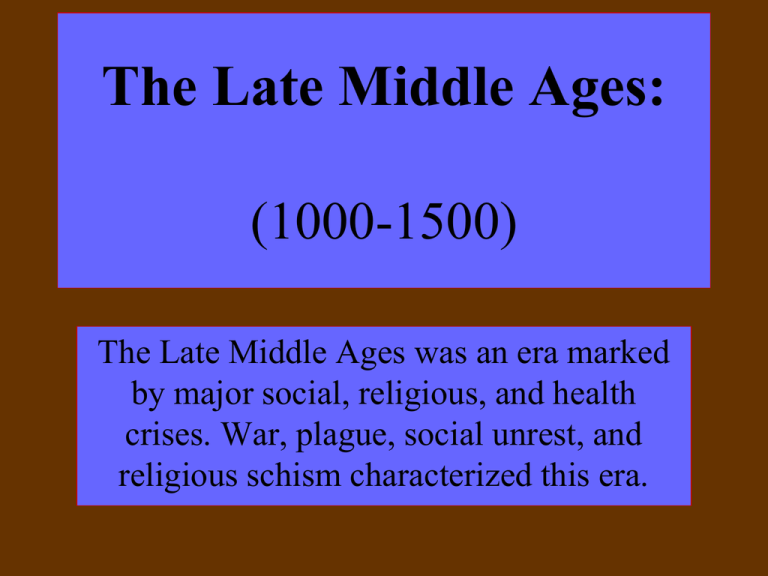
The Late Middle Ages: (1000-1500) The Late Middle Ages was an era marked by major social, religious, and health crises. War, plague, social unrest, and religious schism characterized this era. Start Thinking Research… • • • • • • Popes and Kings The Crusades Medieval Society and Christianity The Hundred Years’ War The Black Death And??? Popes and Kings Rule Europe • Early in the Middle Ages, kings and nobles held power. As time passed, power came to be held by KINGS and POPES. • What is a pope? Where did the word “pope” originate? Who was the first pope? What kind of power did the pope have? Ecclesiastical Breakdown and Revival: The Late Medieval Church • Pope Leo IX (1049) argued that since, St. Peter (the first pope) was leader of the entire Christian Church so also should later popes. The bishop of Constantinople disagreed and in 1054, Pope Leo excommunicated him. • Pope Innocent III (1198-1216) continued to transform the church into a secular power, creating a papal monarchy • Pope Urban IV (1261-1264) continued the secularization of the church by establishing its own law court • The College of Cardinals became the political body within the church. Popes v/s Kings • As popes increased their power, they often conflicted with kings. Kings thought that, as leader, they should be able to select bishops for their own country. Why does it matter? • Pope Gregory VII v/s Emperor Henry IV. • Yikes!!! In 1302, Boniface issued the bull, Unam Sanctum, which declared that temporal authority was subject to the power of the church. • Pope John XXII (r. 1316-1417) tried to restore the papacy of Rome. • John Wycliffe and John Huss led the popular lay movements that protested the rights of the pope. They translated the Bible into the common language and were persecuted by the church. • They were the first Protestant Reformers. Pope Urban II • Pope Urban responded to Byzantium’s request against the Islamic armies with a rousing speech in Clermont, France in 1095 in which he called upon Christians to “Enter upon the road to the Holy Sepulcher; wrest that land from the wicked race, and subject it to yourselves…” • Urban’s speech would help launch the first of several Crusades Reasons for the Crusades • The Byzantine Empire was in severe decline and no longer could act as a buffer between the Muslim East and the Catholic West • Christian pilgrims visiting the holy sites in Jerusalem began experiencing increased harassment and danger “A pilgrim camp near Jericho” by David Roberts 4 Crusades • First Crusade – About 5000 Crusaders left Europe and headed for the Holy Lands. They attacked Jews on the way. They failed. • Second Crusade – French and German kings set off in 1147 to retake the land from the Muslims. They failed. • Third Crusade – England and France led armies against a Muslim held Jerusalem. Ultimately King Richard failed. • Fourth Crusade – French soldiers ended up sacking Constantinople. • The end. Medieval Society and Christianity • In the Middle Ages, life revolved around the church. • Christians wanted to build large Christian “shrines” and travel to holy sites. • When landowners died, they left their land to the church. The church was the largest landowner in Europe. • The church built large universities? Why? The Black Death Also known as The Bubonic Plague, came about as a result of decades of overpopulation, economic depression, famine, and bad health and hygiene in some European regions. The “Black” Death • The Black death was named for the discoloration of the body. • It is believed to have been introduced by seaborne rats from the Black Sea area. • By the early fifteenth century, western Europe had lost as much as 40% of its population to the plague. Who’s to blame? • Lack of sophisticated medicine led to superstitions about the reasons for the plague, including poisonous fumes released during earthquakes and a corruption in the atmosphere. • Jews were sought as scapegoats for the plague and were persecuted. Remedies and Self-Inflicted Pain • Popular remedies against the plague included the use of leeches. • Flagellants believed that beating themselves until they bled would bring about divine intervention. Economic Effects • Farm laborers decreased in numbers • Peasants rebelled against efforts by governments to limit their wages • Opposition to such legislation spurred the English peasants’ revolt of 1381 • And??? The Hundred Years’ War and the Rise of the Nationalist Sentiment • During the Middle Ages, tremendous violence and political unrest led to the breakdown of European governments. • Toward the end of the period, monarchs in England and France began to reassert their power. • The Hundred Years’ War was the result of their struggle for control?? The Hundred Years’ War (1337-1453) • The Hundred years’ War began when the English king Edward III claimed his right to the French throne after the death of Charles IV. • England and France warred with one another for nearly 100 years. • Who won? Edward III Success and Weakness in the War English success in the war was due to its military superiority and its use of weaponry like the longbow. French weakness was due to territorial infighting and a lack of leadership. Joan of Arc (1412-1431) • A peasant from Domrémy who claimed she heard the voices of God, led the French victory in the Battle of Orleans. • Joan served as an inspiration for the French, who eventually defeated the English and won the war. • Joan was later burned at the stake at Rouen as a heretic for refusing to recant her beliefs.
